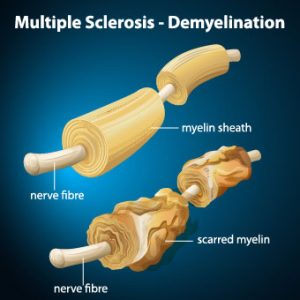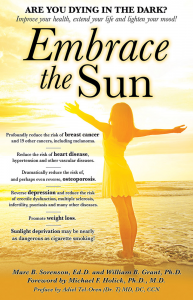Multiple sclerosis is a sunlight-deficiency disease. Another reason to embrace the sun. By Marc Sorenson, EdD
 First of all, multiple sclerosis is a terrible autoimmune disease in which immune cells attack myelin, the protective nerve cover.[1], [2] Hence, this process, known as demyelination, leaves the nerves bare and susceptible to “short circuiting.” This results in a debilitating disease which is often characterized by severe neural and muscular impairments. It may also result in sensory losses, bladder dysfunction, pain and visual problems due to nerve damage.
First of all, multiple sclerosis is a terrible autoimmune disease in which immune cells attack myelin, the protective nerve cover.[1], [2] Hence, this process, known as demyelination, leaves the nerves bare and susceptible to “short circuiting.” This results in a debilitating disease which is often characterized by severe neural and muscular impairments. It may also result in sensory losses, bladder dysfunction, pain and visual problems due to nerve damage.
MS is a big problem!
And recent findings, from National MS Society, estimate 1 million people in the United States have multiple sclerosis. Furthermore, this is more double the last reported number, and the first national research on multiple sclerosis prevalence since 1975. Consequently, it is estimated that about 200 new cases are diagnosed each week in the United States.[3]
Multiple sclerosis and sun exposure: What does new research say?
While no one disputes the horror of an increasing MS rate, a new study reiterates the vital need for sun exposure to prevent MS. Also, we are not surprised about the latest research. Why? Because the new study is simply a reiteration of myriad research papers and opinions showing that more sunlight reduces the risk.
In this research, 151 MS patients defined their previous lifetime sun exposure in the different seasons by questionnaire. In addition, they were compared to 235 non-patients who answered identical questionnaires.[1] As a result, those living in high-UVB areas experienced a 45% lower risk of multiple sclerosis. Living in those areas at ages 5 to 15 years also was associated with a reduced risk of 51-52%. UVB, of course, is a spectrum of light that emanates from the sun and causes tanning. In addition, it is used in sunbeds and sun lamps.
The conclusion regarding MS and sunlight.
In conclusion to their research, the authors stated, “Living in high ambient UVB areas during childhood and the years leading up to MS onset was associated with a lower MS risk. High summer sun exposure in high ambient UVB areas was also associated with a reduced risk.”
While this research is impressive, there is a plethora of additional science. Most noteworthy are the studies that follow. And, all show the association of sun exposure to lowered risk of MS.
Multiple sclerosis and the Davenport study
Probably, the most important early study was from 1922 by Dr. Charles Davenport. He wrote a paper entitled, “Multiple Sclerosis from the standpoint of geographic distribution and race.”[2] He analyzed the multiple sclerosis rates of military draftees and compared it to their states of origin. As a result, he showed that the highest rates were found in men who grew up in Michigan, Wisconsin, and the extreme northwest. These areas, of course, have very low sun availability. There were only a few cases of MS among those who grew up in southern states, where sun availability is abundant. In addition, Dr. Davenport also noted that draftees from urban areas, and where sun availability is low, had 50% higher MS rates than those who came from rural areas. Similar studies confirm that relationship. [3],[4] In 1979, assessments of the MS rates of USA military personnel Produced nearly identical results.[5]
Reducing relapse of multiple sclerosis through sunlight and/or vitamin D.
Mowry and colleagues, in correlating serum vitamin D to the rate of disease relapse, have reported the following: For every increase in serum levels of 10 ng/ml [25 nmol/L], there is a 34% decrease in the risk of relapse in young people.[6] Especially relevant, however, is that 90% of serum levels is derived from sun exposure. And, we also know that sun exposure has protective effects on MS beyond vitamin D.[7] Also, in the aforementioned research on vitamin D, high levels may really be surrogate measures for sun exposure. Sunlight and vitamin D are not the same.
More hours of sun equal lower risk of multiple sclerosis.
Most noteworthy, among people living in geographical locations, where there are 3,000 hours of available sun yearly, multiple sclerosis rates are quite low. [8] The same relationship exists when latitudes are correlated with rates of MS: And, The risk of MS in far northern areas is more than 100 times greater than it is in equatorial areas, where sunlight is intense, and the rate of MS approaches zero.[9], [10]
Therefore, for all who would like to prevent MS or reduce its exacerbation, soak up some regular, non-burning, safe sunlight. In conclusion, this is another of the wonderful benefits of our magnificent sun. It seems like a good time to indulge before the winter comes.
Finally, for more information on multiple sclerosis, read my new book, Embrace the Sun, available at Amazon.
References and footnotes
[1] Helen Tremlett, PhD, Feng Zhu, MSc, Alberto Ascherio, MD, DrPH, and Kassandra L. Munger, ScD.
[2] Davenport, C. Multiple Sclerosis from the standpoint of geographic distribution and race. Arch Neurol Psychiatry 1922;8:
[3] Acheson ED, Bachrach CA, Wright FM. Some comments on the relationship of the distribution of multiple sclerosis to altitude, solar radiation and other variables. Acta Psychiat (Scand) 1960;35 (suppl 147):132-47.51-58
[4] Norman JE Jr, Kurtzke JF, Beebe GW. Epidemiology of multiple sclerosis in USA veterans: 2. Latitude, climate, and risk of multiple sclerosis. J Chron Dis 1983;36:551-59
[5] Kurtzke JF, Beebe GW, Norman JE Jr. Epidemiology of multiple sclerosis in USA veterans: 1. Race, sex, and geographic distribution. Neurology 1979;29:1228-35.
[6] Mowry EM, Krupp LB, Milazzo M, Chabas D, Strober JB, Belman AL, McDonald JC, Oksenberg JR, Bacchetti P, Waubant E. Vitamin D status is associated with relapse rate in pediatric-onset MS. Annals of Neurology 2010;10.1002.
[7] Pantazou V, Schluep M, Du Pasquier R. Environmental factors in multiple sclerosis. Presse Med. 2015 ;44(4 Pt 2):e113-20.
[8] Goldberg, P. Multiple sclerosis: vitamin D and calcium as environmental determinants of prevalence (a viewpoint). Part I: sun, dietary factors and epidemiology. Int J Environ Studies 1974;6:19–27.
[9] Alter M, Yamoor M, Harshe M. Multiple sclerosis and nutrition. Arch Neurol l974;31:267-72.
[10] Kurtkze, J. Geography in multiple sclerosis. J Neurol 1977;215:1-26.
[1] Racke, M. Immunopathogenesis of multiple sclerosis. Ann Indian Acad Neurol. 2009 Oct–Dec; 12(4): 215–220.
[2] Markovic-Plese S, McFarland HF. Immunopathogenesis of the multiple sclerosis lesion. Curr Neurol Neurosci Rep 2001;1:257-62
[3] https://www.healthline.com/health/multiple-sclerosis/facts-statistics-infographic#2
